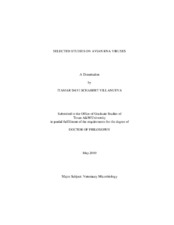| dc.description.abstract | There are many pathogens that infect birds and perhaps many more that researchers have not yet identified. Of all potential pathogens, the research presented in this manuscript focuses on two avian RNA viruses.
First, a serodiagnostic test for newly described Avian Borna Virus (ABV), which has been recently identified as the etiological agent of Proventricular Dilatation Disease (PDD), was developed. PDD is a deadly disease which affects many birds, but to this point, has mainly been a concern of psittacines. The need for a diagnostic test is imperative. An antigen associated with PDD was identified from the brains of affected birds by use of the Western blot assay. This antigen was subsequently purified using various protein purification protocols, including a modification of reverse-phase chromatography. The antigen was then identified as the ABV nucleoprotein according to tandem mass spectroscopy analysis and protein database search. A serodiagnostic assay was developed and standardized using infected cell culture as an antigen source. Over 100 avian serum samples were submitted by veterinarians to test for the presence of antibodies against ABV nucleoprotein. This serodiagnostic assay was found to have 90% sensitivity and 82% specificity for the diagnosis of ABV in infected birds.
Second, the ability of a carbohydrate epitope to enhance the humoral immune response to an influenza vaccine was tested in chickens. Influenza is a serious infection that causes 36,000 deaths annually in the United States. The need for a more efficacious is addressed by incorporating a carbohydrate antigen targeted by natural antibodies that are produced by chickens as well as humans. Therefore, chickens may be a suitable animal model to test this hypothesis. Influenza vaccines with alpha-gal antigen are prepared from cell culture. The antigen is then enzymatically removed from some vaccines and the nature of the ensuing humoral immune response to these vaccines in chickens is attempted.
Though ABV is not known to be zoonotic at this time, zoonotic infections pose the highest risk as new and emerging infectious diseases in the human population. The following research contains applications relative to challenges faced by researchers and clinicians in infectious disease containment. | en |


